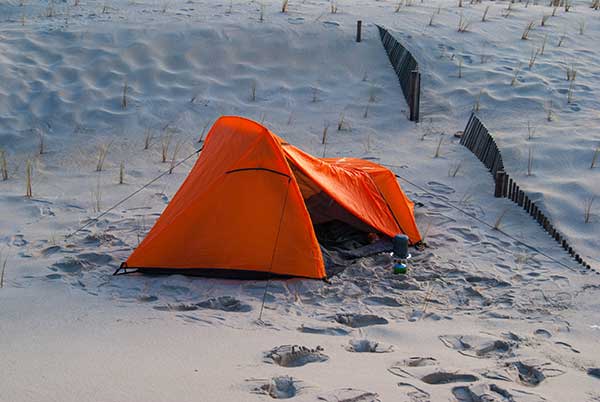A tent footprint basically a heavy-duty piece of material that sits between the tent and the ground. These are usually pegged down at the corners and are the first thing you should lay down when assembling your tent.
However, you may have noticed that the vast majority of modern-day tents come with sewn-in, tubbed floors which are designed to keep water out and ensure your tent floor stays bone dry. However, these ‘sewn-in groundsheets’ can be pretty deceiving, as they give the impression of not needing a footprint.
Regardless of whether your tent comes with a sewn-in groundsheet or not, a tent footprint is essential, and in this article, we’ll be taking you through the reasons for this.

Table of Contents
Prolongs the life of your tent
A footprint acts like an extra layer of protection for your tent.
It’ll protect the bottom of your tent from stones, twigs, and any other sharp objects, and will also reduce wear and tear significantly.
If your tent has a low denier rating (we cover this in more detail below), it’s going to be thinner and as a result, less durable. Thin tent floors need a tent footprint more than those made from a higher denier fabric, however, all tents can ultimately benefit from a footprint.
Adds extra insulation
Again, adding another layer to your tent will increase insulation, as you’re leaving less space between your tent and the ground and this will reduce heat loss.
Most heat escapes to the ground in your tent, so a footprint is the easiest way to reduce the impacts of this.
If it’s particularly cold, combining your footprint with some reflective, heat-trapping foam, and a sleeping mat or airbed, will keep your tent toasty-warm while it’s cold outside.
Prevents water from getting in
Even if your tent is kitted out with covered seams and a tubbed, sewn-in groundsheet, waterproof coatings wear off with time and are not always as protective as we’d like, so a great way to ensure extra protection from wet weather is to use a footprint.
This way you can rest assured that the water has several layers to soak through before getting to your bed and belongings.
Makes pitching your tent easier
Many footprints are tailor-made to match a specific tent, so this can make pitching your tent way easier.
Once you’ve laid down your footprint it acts as an outline for you to line up your tent with. You’ll know exactly where your tent is going and where it needs to be pegged down, which could save you vital camping time, especially if you have limited light.
Packing away is less hassle
One of the issues with relying solely on a sewn-in groundsheet is that if you’ve been camping in muddy, wet conditions, the bottom of your tent is going to be extremely dirty, which can make packing up a hassle.
On the other hand, if you use a separate footprint it will keep the bottom of your tent relatively clean and dry, so you can put the footprint in a separate bag and clean it when you get home.
Things to consider
Denier rating
Your tent’s denier rating will indicate how thick or thin the fabric is. Denier (D) measures the weight of a fabric's thread, so the higher the denier rating, the thicker and more durable the tent will be.
The denier ratings of tent floors can differ dramatically, from super-thin 15D floors to heavy-duty, high-quality 70D ones.
You might not think too much about it, but there’s actually a massive difference between the thickness and durability of a high denier tent and a low one.
A thinner tent floor will tear easily and will also let more cold air and water in, which is why a footprint is always recommended with such tents.
Surface type
Where will you be setting up camp?
The type of terrain you’re camping on will largely influence how much damage is incurred on your tent’s floor. A granite slab or rocky, uneven terrain is far more likely to damage your tent than a soft, forest floor.
You should always scope out the area you’re camping in first and make sure you clear any rocks or sticks away from your pitching spot.
You’ll want somewhere that’s as flat as possible, and even soft forest floors can have hidden rocks and twigs, so ensure you clear the area before setting up camp.
While it’s true that some surfaces will be more damaging than others, it’s a good idea to set down a tent footprint regardless.
DIY footprints
Tent footprints aren’t too expensive, but if you’re looking to save money, there are a number of DIY fixes you can opt for.
You can use 0.7-millimeter thick Polycryo (also called "Polycro"), available on Amazon or from your local hardware store. For an extra-durable option, there’s also a thicker and slightly heavier 1.5-millimeter Polycryo.
Alternatively, you can also use Tyvek for a highly durable DIY footprint. It’s available to buy in bulk on Amazon and is available for around $5 for a 3 x 5-foot section.
There’s always your standard tarp, too. These always come in handy for multiple purposes when camping, however, they’re also bulkier and heavier, so bear this in mind.
Size
Your tent footprint should be slightly smaller than the base of the tent so that water doesn't collect between the footprint and your tent bottom.
If you have a tent footprint that is bigger than your tent, this won’t do much harm in dry weather, but if it’s raining, it won’t do much good.
Material
Tent footprints can come in a variety of materials. The most convenient footprints are made out of polyethylene, which is both durable and easy-to-clean.
Lightweight alternatives will usually be made out of an oxford or lower denier polyester material, but don’t forget, the higher the denier, the more durable the footprint will be.
Cleaning
Cleaning your tent footprint is pretty straightforward.
Simply use a cloth and some warm water to wash away any dirt. If there’s mud encrusted on the footprint, use a scourer instead, but don’t scrub too hard as this could damage the footprint.
Final Verdict
We hope this article has adaquately outlined the reasons for why a tent footprint is necessary.
While you can potentially get away without one if the conditions are dry and the surface you’re camping on is soft, or if your tent has a high denier rating, it’s always best to lay down a tent footprint.
Ultimately, this will increase warmth and add an extra layer of waterproof protection that will also improve the lifespan of your tent.
- Are Merrell Shoes Good? – An Unbiased Review of Merrell Footwear - December 9, 2023
- Where Are Merrell Shoes Made? - December 9, 2023
- Camping in 40-degree Weather: Tips and Tricks - September 25, 2023




![Best Wood for Campfires [Everything You Need To Know] Best Wood for Campfires [Everything You Need To Know]](https://grandcircletrails.com/wp-content/uploads/2021/11/Best-Wood-for-Campfires-1-150x150.jpg)
![Are Hiking Boots Good For Snow? [Everything You Need To Know] Are Hiking Boots Good For Snow? [Everything You Need To Know]](https://grandcircletrails.com/wp-content/uploads/2021/11/Are-Hiking-Boots-Good-For-Snow-1-150x150.jpg)
![How Much Water Do I Need For Camping? [Guide For Beginners] How Much Water Do I Need For Camping? [Guide For Beginners]](https://grandcircletrails.com/wp-content/uploads/2021/12/How-Much-Water-Do-I-Need-For-Camping-1-150x150.jpg)